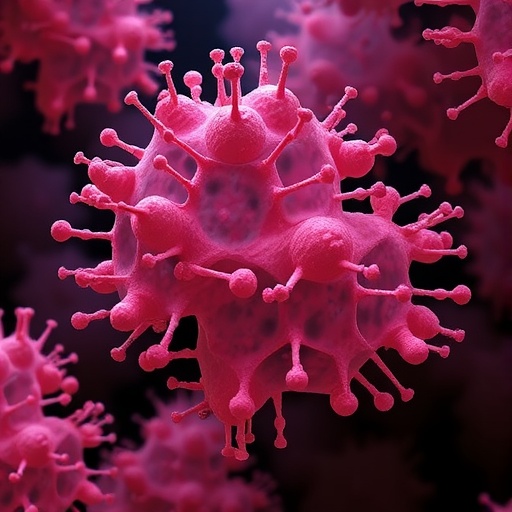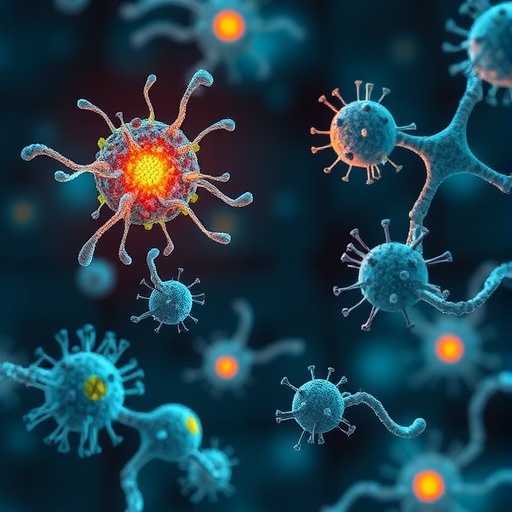In a groundbreaking study recently published in Nature Communications, researchers have unveiled novel insights into the molecular mechanisms underpinning the DNA repair processes of Mycobacterium tuberculosis (Mtb), the pathogen responsible for the infectious disease tuberculosis. The study reveals that the Ku protein from Mtb undergoes oligomerisation—a process where multiple Ku units join together—and that this structural assembly significantly promotes DNA synapsis, a crucial early event in DNA double-strand break (DSB) repair. This finding not only deepens our understanding of how Mtb maintains genome integrity under stress but also suggests potential avenues for novel antimicrobial strategies targeting bacterial DNA repair machinery.
The preservation of genomic stability is fundamental to all organisms, especially for pathogenic bacteria like Mtb that constantly face hostile environments, such as exposure to reactive oxygen and nitrogen species within host immune cells. Among the various DNA repair pathways, the non-homologous end joining (NHEJ) mechanism is particularly critical in prokaryotes for repairing DSBs. The Ku protein is a key player in bacterial NHEJ, recognizing and binding DNA ends to facilitate their subsequent ligation. However, the molecular intricacies of Ku’s function in Mtb, particularly regarding its structural dynamics and interactions with DNA, remained elusive until now.
Leveraging advanced biophysical techniques, including cryogenic electron microscopy (cryo-EM) and small-angle X-ray scattering (SAXS), the research team led by Zahid et al. meticulously dissected the oligomerisation behavior of Mtb Ku. Their experiments demonstrated that Mtb Ku does not simply bind DNA as a monomer or dimer; instead, it forms higher-order oligomers that bring two DNA ends into close proximity, effectively promoting synapsis. This synapsis is a prerequisite for efficient DNA repair, ensuring that the broken DNA ends are held together correctly for subsequent enzymatic processing.
This oligomerisation phenomenon was observed under both in vitro and in vivo conditions, indicating its physiological relevance in Mtb’s DNA damage response. Intriguingly, the oligomeric interfaces involve specific protein domains that mediate protein-protein interactions necessary for stabilizing the synaptic complex. The study identified structural motifs that are unique to Mtb Ku compared to its eukaryotic counterparts, hinting at evolutionary adaptations of this pathogen to optimize DNA repair under the pressures of the host environment.
Moreover, biochemical assays revealed that oligomerisation enhances the affinity of Ku for DNA ends, thereby increasing the efficiency and accuracy of the NHEJ repair process. This enhanced binding capability could be a critical factor in Mtb’s remarkable ability to persist within the hostile milieu of human macrophages, where DNA damage is frequent due to immune-mediated attacks. By stabilizing broken DNA ends through oligomer formation, Mtb Ku ensures rapid repair, aiding in bacterial survival and persistence.
These findings carry profound implications for tuberculosis treatment strategies. Since the NHEJ pathway, and Ku protein specifically, is essential for Mtb to survive genotoxic stress, disrupting Ku oligomerisation emerges as a promising target for novel therapeutics. Drugs designed to interfere with Ku’s ability to oligomerise or bind DNA could effectively sensitize Mtb to DNA-damaging agents or host immune defenses, potentially curbing persistent infections and preventing the emergence of drug resistance.
The structural insights provided by this study also open up possibilities for structure-guided drug design. The detailed maps of Ku oligomer interfaces and DNA-binding domains can inform the development of small molecules or peptides that selectively inhibit Mtb Ku without affecting human DNA repair enzymes. Such specificity is pivotal for reducing off-target effects and enhancing therapeutic efficacy.
Beyond tuberculosis, the research contributes to the broader understanding of bacterial DNA repair systems. While Ku proteins are conserved across many prokaryotes, the oligomerisation behavior observed in Mtb may represent an evolutionary innovation to address specific challenges faced by this pathogen. Comparative studies with Ku proteins from other bacteria could reveal how DNA repair mechanisms have diversified to fit different ecological niches and stress conditions.
Further research inspired by these findings may investigate how Ku oligomerisation integrates with other components of the Mtb DNA repair machinery, such as the ligase D enzyme. Understanding the coordinated action of these factors will be key to fully elucidating the bacterial NHEJ process. Additionally, analyses of Ku mutants deficient in oligomerisation could shed light on the precise role of this structural assembly in bacterial fitness and virulence.
In parallel, there is potential for leveraging this knowledge in diagnostic technologies. For instance, assays detecting Ku oligomerisation states could serve as biomarkers for bacterial responses to DNA damage, providing insights into the effectiveness of antibiotic treatments or immune system pressures. Such tools would be invaluable in clinical settings, aiding in the management of tuberculosis cases.
The study by Zahid et al. exemplifies the power of interdisciplinary approaches, combining structural biology, microbiology, and biochemistry to unravel complex biological phenomena. These integrative strategies are increasingly vital in tackling pressing global health challenges posed by persistent infectious diseases like tuberculosis, which continue to afflict millions worldwide.
In summary, the oligomerisation of Ku from Mycobacterium tuberculosis represents a crucial mechanism promoting DNA synapsis and genome maintenance during the bacterial DNA damage response. This novel insight not only advances fundamental microbiological knowledge but also highlights new targets for antimicrobial intervention. With tuberculosis remaining a top cause of infectious mortality globally, such advancements bring hope for more effective treatments in the years ahead.
Subject of Research: DNA repair mechanisms in Mycobacterium tuberculosis, focusing on the structure and function of the Ku protein in non-homologous end joining (NHEJ).
Article Title: Oligomerisation of Ku from Mycobacterium tuberculosis promotes DNA synapsis.
Article References:
Zahid, S., Baconnais, S., Smith, H. et al. Oligomerisation of Ku from Mycobacterium tuberculosis promotes DNA synapsis. Nat Commun 16, 10568 (2025). https://doi.org/10.1038/s41467-025-65609-y
Image Credits: AI Generated
DOI: https://doi.org/10.1038/s41467-025-65609-y
Tags: antimicrobial strategies targeting DNA repairbacterial genome integrity under stressbiophysical techniques in molecular biologyDNA synapsis and double-strand break repairinsights into pathogenic bacteria DNA repairKu protein oligomerisation in bacteriamolecular dynamics of Ku proteinMycobacterium tuberculosis DNA repair mechanismsnon-homologous end joining in Mycobacteriumreactive oxygen species and bacteriastructural assembly of Ku proteintuberculosis pathogen DNA repair processes





